Bellona (goddess)
Bellona (IPA: [bɛlˈloːna]) was an ancient Roman goddess of war. Her main attribute is the military helmet worn on her head; she often holds a sword, spear, or shield, and brandishes a torch or whip as she rides into battle in a four-horse chariot. She had a temple near the Theatre of Marcellus. Her iconography was extended by painters and sculptors following the Renaissance.
| Bellona | |
|---|---|
Goddess of War, Destruction, Conquest, and Bloodlust | |
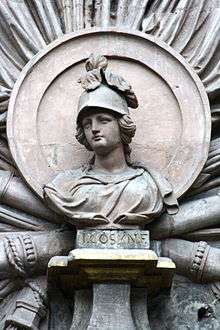 A bust of Bellona by Jean Cosyn, a 1697 victory celebration over a Brussels doorway | |
| Symbol | Military helmet and torch |
| Personal information | |
| Parents | Jupiter and Juno |
| Siblings | Mars, Vulcan, Juventas, Discordia, Lucina |
| Consort | Mars |
| Greek equivalent | Enyo |
Etymology
The goddess of war Bellōna is a derivative of the Latin word bellum ('war, warfare'; from an older duellum), possibly stemming from *duenelo- ('quite good, quite brave'), a reconstructed diminutive of the word bonus ('good'; attested as duenos in early Old Latin).[1] According to linguist Michiel de Vaan, "its use in the context of war (bella acta, bella gesta) could be understood as a euphemism, ultimately yielding a meaning 'action of valour, war' for the noun bellum." The name of the goddess is also attested as the genitive singular Duelonai in an inscription.[1]
Cult and temples
Originally named Duellona in the Italic languages,[2] the cult figure who became Bellona was an ancient Sabine goddess of war and identified with Nerio, the consort of the war god Mars - and later with the Greek Enyo. Her first temple in Rome was dedicated in 296 BCE, where her festival was celebrated on 3 June.[3] Her priests were known as Bellonarii and used to wound their own arms or legs as a blood sacrifice to her.[4] These rites took place on 24 March, called the day of blood (dies sanguinis), after the ceremony. In consequence of this practice, which approximated to the rites dedicated to Cybele in Asia Minor, both Enyo and Bellona became identified with her Cappadocian aspect, Ma.[5]
The Roman Campus Martius area, in which Bellona’s temple was situated, had extraterritorial status. Ambassadors from foreign states, who were not allowed to enter the city proper, stayed in this complex. Since the area of the temple was outside the pomerium, the Senate met there with ambassadors and received victorious generals prior to their triumphs. Beside the temple was the war column (columna bellica), which represented non-Roman territory. To declare war on a distant state, a javelin was thrown over the column by one of the priests concerned with diplomacy (fetiales) in a modification of the archaic practice, from Roman territory toward the direction of the enemy land and this symbolical attack was considered the opening of war.[6]
In the military cult of Bellona, she was associated with Virtus, the personification of valour. She then travelled outside Rome with the imperial legions and her temples have been recorded in France, Germany, Britain, and North Africa.[7]
Representation in the arts
Poetry
Often in poetry the name Bellona is used simply as a synonym for war, although in the Thebaid of Statius the goddess appears as a character, representing the destructive and belligerent aspect of war. There she is described as carrying a spear and a flaming torch or riding in a chariot and waving a blood-stained sword.[8] Classical allusions to Bellona later appear in Shakespeare's plays in the appropriate context of warrior characters: Hotspur describes the goddess as "the fire-eyed maid of smoky war", for example,[9] and Macbeth is referred to as "Bellona's bridegroom",[10] that is to say, the equivalent of Mars.
In more modern times, Adam Lindsay Gordon dedicated an energetic Swinburnean evocation of the "false goddess" who leads men astray in his poem "Bellona", published in Australia in 1867.[11] She also figures in Edgell Rickword's World War I poem "The Traveller". There the poet describes himself as marching toward the front line in the company of Art, the god Pan, and the works of Walter Pater. Meeting Bellona as they approach the fighting, one by one the pleasurable companions are forced to flee before the violence of war, until the goddess rejoices in having him to herself.[12]
Cantata and opera
Bellona appears in the prologue of Rameau's opera, Les Indes Galantes (1735), in which the call of love ultimately triumphs over that of war.[13] In a Bach dramma per musica performed two years before, Tönet, ihr Pauken! Erschallet, Trompeten! BWV 214, the goddess even quitted her usual ferocity in order to congratulate Maria Josepha of Austria, Princess Elector of Saxony and Queen of Poland, on her birthday on 8 December 1733.[14]
She retains her harsh aspect in "Prometheus Absolved" by Giovanni Ambrogio Migliavacca (1718–1795), however. In this cantata celebrating the birth of the Archduchess Isabella in 1762, the deities sit in judgement on Prometheus, some arguing for clemency, while Bellona and others demand rigour.[15] She also plays her proper part in the 'heroic cantata' created by the composer Francesco Bianchi and the librettist Lorenzo da Ponte, entitled "The Wedding of the Thames and Bellona" (Le nozze del Tamigi e Bellona). This was performed in London to mark the British naval victory over the Spanish at the Battle of Cape St. Vincent (1797).[16]
Painting and sculpture
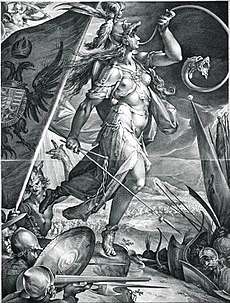
Bellona is commonly portrayed wearing a plumed helmet and dressed in armour, or at least a breastplate with a skirt beneath. In her hand she carries a spear, shield, or other weapons, and occasionally, she sounds a trumpet for the attack. Anciently she was associated with the winged Victory holding a laurel crown in her hand, a statue of whom she sometimes carries; when she appears on war memorials she may hold that attribute.
Examples of such an armoured figure appear in the 1633 painting attributed to Rembrandt in the Metropolitan Museum of Art,[17] and statues by Johann Baptist Straub (1770) and Johann Wilhelm Beyer (1773–80). In the latter she appears with the god Janus, since both were associated with the Roman ceremonies of declaring war. In the case of Janus, the doors to his temple were left open during the whole period of hostilities.
Straub's statue (below) has a gorgon head on her shield to instil terror in her enemies, as does the Rembrandt painting, although this was added later, probably as a response to other examples of this new iconographical departure.[18] In the bust by Bertram Mackennal she wears a gorgon mounted on her helmet, while in other depictions it is on the breastplate. Jean Léon Gérôme takes the representation of the horror of war even further in his glazed bust of the goddess (1892). Not only is she wearing a head about her neck, but the fierce demeanour of the screaming face, surmounted by an angular winged helmet, makes her resemble a gorgon herself.[19]
Another common innovation was Bellona’s association with cannons, as in the drawing by Hans Krieg (1590–1645) [20] and the 1700 ceiling fresco at Hammerschloss Schmidmühlen by Hans Georg Asam (1649–1711).[21] An early Dutch engraving in a series of prints depicting Personifications of Industrial and Professional Life suggests that it is this goddess who inspires the invention of war materiels, showing her seated in a factory workshop with all manner of arms at her feet (plate 6, see the Gallery below). In the fresco by Constantino Brumidi in the U.S. Capitol (1855–60), her image is updated. There she is shown standing next to an artillery piece and has the stars and stripes on her shield.
Not all representations of Bellona wear armour. The statues by Alvise Tagliapietra at St. Petersburg (c.1710) and that at the J. Paul Getty Museum by Augustin Pajou (1775/85) [22] are largely naked, although otherwise wearing or carrying some of the other attributes of the goddess. There are Classical references that sanction this, however. In Gaius Valerius Flaccus' Argonautica, for example, appears the description "Bellona with bare flank, her brazen weapons clanging as she moved" (3. 60).[23] A further poetic reference taken up by a painter occurs in Louis Jean François Lagrenée's "Bellona Presenting the Reins of his Horses to Mars" (1766). This illustrates a speech from Claudian's In Ruffinum where Mars requests "Let Bellona bring my helmet and Terror guide the reins" (Fer galleam Bellona mihi, nexusque rotarum tende Pavor).[24] Jan van Mieris’ allegorical painting of "Wisdom restraining Bellona" (1685) is also poetic. There the seated figure of Wisdom clasps the right hand of the helmeted goddess, who is turning to leave, her cloak fluttering behind her and her shield held high in her outstretched left hand.[25]
Public statements
As well as having a decorative function, representations of the goddess had a public function too. Batholomaeus Spranger's "Bellona Leading the Imperial Armies against the Turks" (see above) played its part in Austria's anti-Turkish propaganda during the Long Turkish War. A later phase of the continuing conflict, culminating in victory at the battle of Zenta in 1697, is marked by Jean Cosyn's celebratory doorway in Brussels in what now is known as the Maison de Bellone, at the centre of which presides the helmeted bust of the goddess surrounded by military standards and cannons.[26]
A dynastic political statement is made in "Marie de Medici as Bellona" (1622/5), designed by Peter Paul Rubens for her public rooms in the Luxembourg Palace. He represents her there as a wielder of political power at a time when it, in fact, had waned.[27] She is standing with armour, cannons, and muskets at her feet, and her triumphs are underlined by emblems of victory. She carries a small statue of the winged goddess in her right hand, a smaller winged figure is mounted below the plumes of her helmet, while cupids hover above her, holding a laurel crown. Her portrayal contrasts with Rembrandt's depiction of Bellona with the homely features of an ordinary Dutchwoman. This makes an anti-imperial statement, with the assurance that the new Dutch Republic is ready to defend itself, particularly against Spain, during the Thirty Years' War.[28]
Auguste Rodin's sculpture of a head of Bellona (1879) originally was created for a monument to the French Third Republic and shows even more belligerence. Modelled on his mistress Rose Beuret while in a bad mood, the head is drawn back in proud anger, turning in dynamic movement to look along the line of her right shoulder.[29] Defence in war is the message of Georg Kolbe's Bellona fountain in Wuppertal. Originally commissioned in 1915, it depicted the helmeted goddess carrying a sword in her left hand and inspiring a kneeling young man. The statue was not erected until 1922, by which time it functioned as a war memorial.[30]
The use of Bellona in such structures was well established before this, dating back to her prominent use in Jean Cosyn's doorway. The Temple of Bellona, designed by William Chambers for Kew Gardens in 1760, was projected as a celebration of the Anglo-Hanoverian war effort during the Seven Years' War and eventually housed plaques honouring the regiments that served in it.[31] These, however, related primarily to remembrance of victory rather than of the fallen. It was not until a century afterward that the French-Canadian victims of the Seven Years War were commemorated by a monument at Quebec. Atop a tall column on the site of the battlefield, Bellona looks down, carrying a shield and laurel crown in her right hand.[32] The statue was presented by Jérôme-Napoléon in 1862 as a gesture of reconciliation.[33]
The Australian dead from the Gallipoli Campaign were commemorated by a bronze bust of Bellona by Bertram Mackennal, a former student of Rodin. This he presented to the Australian government in Canberra as a memorial in 1916.[34] As in Rodin's bust, the helmeted head is turned to the right, but the breasts are more in evidence. The fallen generally make their appearance later in such structures where Bellona is present. They accompany the sword-wielding goddess in Douglas Tilden's monument to the California Volunteers during the Spanish–American War of 1898;[35] in the Bialystok memorial to the dead in the Polish–Soviet War in 1920, she stands behind a soldier and holds aloft a laurel crown.[36]
The Bellona on the First World War victory archway at Waterloo station is particularly memorable, however. Beneath the demonic sword-brandishing wraith with her gorgon necklace, cower and mourn, not the dead, but the overlooked living victims of war.[37]
Gallery
 Bellona in armour, attributed to Rembrandt, 1633
Bellona in armour, attributed to Rembrandt, 1633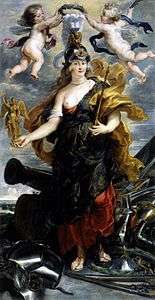 "Marie de Medici as Bellona" by Peter Paul Rubens, 1621–25
"Marie de Medici as Bellona" by Peter Paul Rubens, 1621–25 Bellona Presenting the Reins of his Horses to Mars, Louis Jean François Lagrenée, 1766
Bellona Presenting the Reins of his Horses to Mars, Louis Jean François Lagrenée, 1766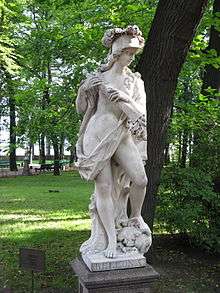 Alvise Tagliapietra's unclothed goddess, c. 1710, Saint Petersburg
Alvise Tagliapietra's unclothed goddess, c. 1710, Saint Petersburg Janus and Bellona by Johann Wilhelm Beyer, 1773–80, Schönbrunn
Janus and Bellona by Johann Wilhelm Beyer, 1773–80, Schönbrunn Bertram Mackennal 1916 Gallipoli war memorial, Canberra
Bertram Mackennal 1916 Gallipoli war memorial, Canberra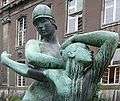 Georg Kolbe's Wuppertal fountain, 1915/22
Georg Kolbe's Wuppertal fountain, 1915/22 "Bellona inspires the invention of arms", Philip Galle, 1574
"Bellona inspires the invention of arms", Philip Galle, 1574 Constantino Brumidi's fresco in the U.S. Capitol, 1855–60
Constantino Brumidi's fresco in the U.S. Capitol, 1855–60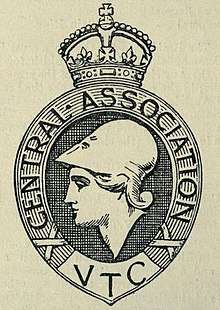 Bellona on the badge of the Volunteer Training Corps in World War I
Bellona on the badge of the Volunteer Training Corps in World War I
References
- de Vaan 2008, p. 70.
- Varro, On the Latin Language, VIII.49.
- Encyclopedia of Ancient Mediterranean Religions (2016), p.136
- William Smith, Smaller Classical Dictionary, London 1862, p.77
- "Cults of Enyo and Ma" at Theoi Archived May 17, 2016, at the Wayback Machine
- "Fetiales", Encyclopædia Britannica Archived August 1, 2016, at the Wayback Machine
- Glenys Lloyd-Morgan, "Nemesis and Bellona" in The Concept of the Goddess, London 1996, pp.125-6
- Included in the "Enyo" article at Theoi Archived May 17, 2016, at the Wayback Machine
- Henry IV part 1, (IV.i.119)
- Macbeth I.ii.54
- Sea Spray and Smoke Drift, poem 10 Archived September 12, 2015, at the Wayback Machine
- Published in Behind the Eyes (1921)
- Cuthbert Girdlestone, Philip Gossett, Jean-Philippe Rameau: His Life and Work, Dover Publications 1969, pp.323-4
- BWV 214, Leipzig 1733; translations of the aria and recitative are on Emmanuel Music}}
- Migliavacca, Giovanni Ambrogio (1 January 1762). Prometeo assoluto serenata cantata in Vienna per comando degli augustissimi regnanti in occasione del felicissimo parto di s.a. reale l'arciduchessa Isabella [Giannambrogio Migliavacca]. Retrieved 24 October 2016 – via Internet Archive.
- Sheila Hodges, Lorenzo Da Ponte: The Life and Times of Mozart's Librettist, University of Wisconsin 2002, p.150
- Ernst van de Wetering, A Corpus of Rembrandt Paintings VI: Rembrandt's Paintings Revisited, Dordrecht NL 2014, p.529
- "Rembrandt (Rembrandt van Rijn) - Bellona - The Met". Retrieved 24 October 2016.
- [Sotherby’s description
- Krieg, Creator:Hans (1 January 1620). "Bellona". Retrieved 24 October 2016 – via Wikimedia Commons.
- Altenbuchner, Klaus Anton (30 November 1899). "Deutsch: Bellona von Hans Georg Asam, Hammerschloss Schmidmühlen". Retrieved 24 October 2016 – via Wikimedia Commons.
- Getty Museum site Archived April 2, 2015, at the Wayback Machine
- "Bellona" section at Theoi Archived May 17, 2016, at the Wayback Machine
- Quoted in Casimir Simienowicz, The great art of artillery, London 1729, p.347
- "WI-ID PDF". Retrieved 24 October 2016.
- Photographs on the Brussels Pictures site
- Jane Kromm, The Art of Frenzy: Public Madness in the Visual Culture of Europe, London and New York 2003, p.40
- "Rembrandt (Rembrandt van Rijn) - Bellona - The Met". Retrieved 24 October 2016.
- Margherita Andreotti, "Bellona" in Rodin's Art, OUP USA 2003, pp.51-60
- "Georg Kolbes Brunnen und Skulptur "Bellona" - Denkmal-Wuppertal.de". Retrieved 24 October 2016.
- Vanessa Berridge, The Princess's Garden: Royal Intrigue and the Untold Story of Kew, Stroud (Glos.) 2015, chapter 15
- Asclepias, Photo (20 August 2010). "Français : Statue représentant Bellone, au sommet du monument des Braves, à l'entrée du parc des Braves, à Québec (Québec, Canada). La statue a été offerte par le prince Jérôme-Napoléon en 1862. Elle est haute d'environ trois mètres et forme le sommet du monument haut de 22 mètres. Elle a été installée, et le monument inauguré, le 19 octobre 1863. Elle est peut-être inspirée d'un croquis d'Eugène-Étienne Taché [1]". Retrieved 24 October 2016 – via Wikimedia Commons.
- Une espace consacrée aux braves Archived March 9, 2016, at the Wayback Machine
- "BELLONA GODDESS OF WAR". Retrieved 24 October 2016.
- Art and Architecture Archived February 20, 2016, at the Wayback Machine
- Wikimedia Commons
- "WW1 100: London's Memorials - View from the Mirror - Page 2". Retrieved 24 October 2016.
Bibliography
- de Vaan, Michiel (2008). Etymological Dictionary of Latin and the other Italic Languages. Brill. ISBN 9789004167971.CS1 maint: ref=harv (link)
External links
| Look up Bellona in Wiktionary, the free dictionary. |
| Wikisource has the text of the 1911 Encyclopædia Britannica article Bellona. |
- Images of Bellona in the Warburg Institute Iconographic Database
